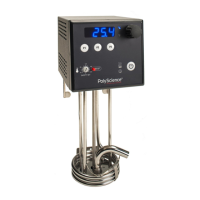3.4 Set-Up
The Immersion Circulator may be clamped directly to the side of a
reservoir (user supplied) or to a support rod adjacent to the
reservoir. To produce the best fluid circulation, the rotating pump
outlet nozzle should be pointed along one side of the reservoir
wall.
The liquid in the reservoir should be maintained at a depth
sufficient to fully immerse the heater coils, over-temperature
sensor, and pump outlet nozzle.
When using a plastic reservoir, be sure to position the Circulator so
that the heater coils do not contact the sides or bottom of the tank.
3.5 Connections to External Apparatus
Although not designed for closed loop circulation (the Immersion
Circulator does not have inlet and outlet fittings), it may be used for
this purpose.
To connect the Immersion Circulator to an external apparatus, slide
½ inch ID (13mm) tubing over the rotating pump outlet nozzle and
fasten it in place with a hose clamp. Connect the other end of the
tubing to the inlet of the external apparatus. Be sure to run tubing
from the outlet of the external apparatus back to the reservoir to
return the fluid.
3.6 Attainable Temperatures
An Immersion Circulator can be used with reservoirs of various capacities and shapes as well as
with different fluids. These variables may adversely affect temperature accuracy and stability. For
example, a reservoir with large surface area loses heat more quickly, which may prevent the
Circulator from attaining the desired temperature.
The following chart is intended as an approximate guide to temperature performance expectations
under various conditions:
Approximate Attainable Temperatures vs. Liters In Uncovered Reservoir
Temperature 30°C 40°C 50°C 60°C 70°C 80°C 90°C 100°C 110°C 120°C 130°C 140°C 150°C
Water 192L 96L 48L 24L 12L 6L 3L – – – – – –
Oil 283L 202L 145L 103L 74L 53L 38L 27L 19L 14L 10L 7L 5L
Results may vary.
Minimum
immersion
level

